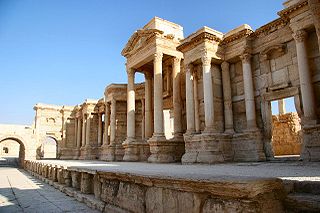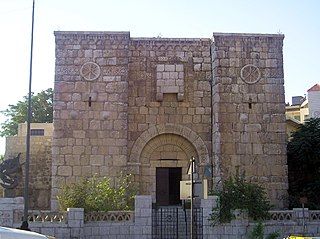The 630s decade ran from January 1, 630, to December 31, 639.

Year 634 (DCXXXIV) was a common year starting on Saturday of the Julian calendar. The denomination 634 for this year has been used since the early medieval period, when the Anno Domini calendar era became the prevalent method in Europe for naming years.

Year 638 (DCXXXVIII) was a common year starting on Thursday of the Julian calendar. The denomination 638 for this year has been used since the early medieval period, when the Anno Domini calendar era became the prevalent method in Europe for naming years.

Year 642 (DCXLII) was a common year starting on Tuesday of the Julian calendar. The denomination 642 for this year has been used since the early medieval period, when the Anno Domini calendar era became the prevalent method in Europe for naming years.
Domnall Brecc was king of Dál Riata, in modern Scotland, from about 629 until 642. He was the son of Eochaid Buide. He was counted as Donald II of Scotland by the scholar Fraxinius.

The Battle of the Yarmuk was a major battle between the army of the Byzantine Empire and the Arab Muslim forces of the Rashidun Caliphate. The battle consisted of a series of engagements that lasted for six days in August 636, near the Yarmouk River, along what are now the borders of Syria–Jordan and Syria-Israel, southeast of the Sea of Galilee. The result of the battle was a decisive Muslim victory that ended Roman rule in Syria after about seven centuries. The Battle of the Yarmuk is regarded as one of the most decisive battles in military history, and it marked the first great wave of early Muslim conquests after the death of the Islamic prophet Muhammad, heralding the rapid advance of Islam into the then-Christian/Roman Levant.

The Muslim conquest of Persia, also called the Muslim conquest of Iran, the Arab conquest of Persia, or the Arab conquest of Iran, was a major military campaign undertaken by the Rashidun Caliphate between 632 and 654. As part of the early Muslim conquests, which had begun under Muhammad in 622, it led to the fall of the Sasanian Empire and the eventual decline of Zoroastrianism, which had been predominant throughout Persia as the nation's official religion. The persecution of Zoroastrians by the early Muslims during and after this conflict prompted many of them to flee eastward to India, where they were granted refuge by various kings.
Domnall mac Áedo, also known as Domnall II, was an Irish king and son of Áed mac Ainmuirech and his consort Land, the daughter of Áed Guaire mac Amalgada of Airgíalla. Domnall was High King of Ireland from 628 until his death. He belonged to the Cenél Conaill kindred of the Northern Uí Néill.
Congal Cáech was a king of the Cruthin of Dál nAraidi in the medieval Irish province of Ulaid, from around 626 to 637. He was king of Ulaid from 627–637 and, according to some sources, High King of Ireland.

The Battle of Walaja was fought in Mesopotamia in May 633 between the Rashidun Caliphate army under Khalid ibn al-Walid and Al-Muthanna ibn Haritha against the Sassanid Empire and its Arab allies.

The Muslim conquest of the Levant, or Arab conquest of Syria, was a 634–638 CE invasion of Byzantine Syria by the Rashidun Caliphate. A part of the wider Arab-Byzantine Wars, the Levant was brought under Arab Muslim rule and developed into the provincial region of Bilad al-Sham. Clashes between the Arabs and Byzantines on the southern Levantine borders of the Byzantine Empire had occurred during the lifetime of Muhammad, with the Battle of Muʿtah in 629 CE. However, the actual conquest did not begin until 634, two years after Muhammad's death. It was led by the first two Rashidun caliphs who succeeded Muhammad: Abu Bakr and Umar ibn al-Khattab. During this time, Khalid ibn al-Walid was the most important leader of the Rashidun army.

The Battle of Ullais was fought between the forces of the Rashidun Caliphate and the Sasanian Persian Empire in the middle of June 633 AD in Iraq, and is sometimes referred to as the Battle of Blood River since, as a result of the battle, there were enormous amounts of Persian Sasanian and Arab Christian casualties.

The Battle of the Iron Bridge was fought between the Muslim Rashidun army and the Byzantine army in 637 AD. The battle took its name from a nearby nine-arch stone bridge spanning the Orontes River which had gates trimmed with iron. It was one of the last battles fought between the Byzantines and Rashidun Caliphate in the province of Syria. The aftermath of the battle marked the nearly complete annexation of the province into the Rashidun Caliphate with the fall of its capital, Antioch.

The Rashidun Caliphate consisted of the first four successive caliphs (lit. 'successors') — Abu Bakr, Umar, Uthman, and Ali — who led the Muslim community/polity from the death of the Islamic prophet Muhammad in 632, to the establishment of the Umayyad Caliphate in 661. The Caliphate's first 25-years were characterized by rapid military expansion during which it was the most powerful economic, cultural, and military force in West Asia and Northeast Africa. By the 650s, in addition to the Arabian Peninsula, the caliphate had subjugated the Levant to the Transcaucasus in the north; North Africa from Egypt to present-day Tunisia in the west; and the Iranian Plateau to parts of Central and South Asia in the east. The caliphate ended in a five-year period of internal strife. The title Rashidun comes from the belief in Sunni Islam that the caliphs were 'rightly guided', and therefore constituted a religious model to be followed and emulated. The caliphs are also known in Muslim history as the "orthodox" or "patriarchal" caliphs.

The siege of Damascus (634) lasted from 21 August to 19 September 634 before the city fell to the Rashidun Caliphate. Damascus was the first major city of the Eastern Roman Empire to fall in the Muslim conquest of Syria.

The siege of Jerusalem (636–637) was part of the Muslim conquest of the Levant and the result of the military efforts of the Rashidun Caliphate against the Byzantine Empire in the year 636–637/38. It began when the Rashidun army, under the command of Abu Ubayda, besieged Jerusalem beginning in November 636. After six months, Patriarch Sophronius agreed to surrender, on condition that he submit only to the caliph. In 637 or 638, Caliph Umar traveled to Jerusalem in person to receive the submission of the city. The patriarch thus surrendered to him.
The Battle of Moira, also known as the Battle of Magh Rath, was fought in the summer of 637 by the High King of Ireland, Domnall II, against his foster son Congal Cáech, King of Ulaid, supported by his ally Domnall Brecc, King of Dál Riata. The battle resulted in a decisive victory for the High King and his army, and Congal Cáech was killed in the fighting.

The Arab conquest of Mesopotamia was carried out by the Rashidun Caliphate from 633 to 638 AD. The Arab Muslim forces of Caliph Umar first attacked Sasanian territory in 633, when Khalid ibn al-Walid invaded Mesopotamia, which was the political and economic centre of the Sasanian state. From 634 to 636 AD, following the transfer of Khalid to the Byzantine front in the Levant, the hold of Arab forces on the region weakened under the pressure of Sasanian counterattacks. A second major Arab offensive in 636 and ended in January 638 with the capture of Mosul and the consolidation of Arab control over and exclusion of Sasanid influence from the whole Mosul-Tikrit region.
The Battle of Fid Eoin was fought in early medieval Ireland between the kingdoms of Dál Riata and Dál nAraidi in either 629 or 630. The forces of Dál Riata were led by their king Connad Cerr, whilst the Dál nAraidi were led by Máel Caích, brother of Congal Cáech who was the king of the Dál nAraidi and the over-kingdom of Ulaid. The result of the battle was a decisive defeat of the Dál Riata.
Battle of Babylon was fought between the forces of Sasanian Empire and Rashidun Caliphate in 634. Muslim Arabs won the encounter to maintain their pursuit of conquering Mesopotamia. After this battle, the Arabs would go on to conquer Ctesiphon and the rest of Iraq from the Persians.













